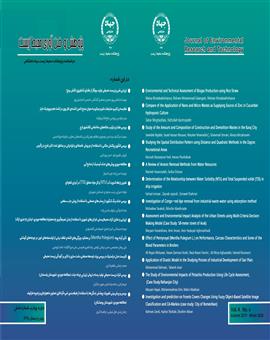کاربست مدل دراستیک در بررسی روند توسعه صنعتی دشت ساری با تاثیر بر آلودگی زیست محیطی
محورهای موضوعی : آلودگی منابع آب
1 - استادیار گروه علوم محیط زیست
2 - دانشگاه شیراز
کلید واژه: آسیبپذیری, دراستیک, ساری, آبخوان, توسعه صنعتی,
چکیده مقاله :
در ایجاد شهرکهای جدید صنعتی به منظور پاسخگویی به نیازهای مردم بایستی به عوامل و فاکتورهای موثر در حفاظت، مدیریت و توسعه پایدار آبخوانها و منابع آبی موجود در یک دشت توجه گردد. لذا بررسی پتانسیل آسیبپذیری آبخوان جهت مکانیابی شهرکهای جدید صنعتی لازم و ضروری می باشد. در این تحقیق، جهت ارزیابی عوامل هیدروژئولوژیکی اثرگذار در مکانیابی شهرکهای صنعتی در دشت ساری به عنوان مطالعه موردی، نقشه خطرپذیری دشت با استفاده از مدل دراستیک تهیه گردید. نتایج حاصل از مدل دراستیک نشان داد که آسیبپذیری آبخوان دشت ساری در سه گروه آسیبپذیری بالا (49/10 درصد)، بسیار بالا (66/56 درصد) و بسیار بسیار بالا (85/32 درصد) قرار می گیرد. تحلیل حساسیت به دو روش تک پارامتری و حذف پارامتر مشخص مینماید که عامل عمق آب زیرزمینی بیشترین حساسیت را در شاخص آسیبپذیری دراستیک ایجاد میکند. آبخوان دشت ساری به دلیل عمق کم آب زیرزمینی به شدت تحت تأثیر آلایندههای حاصل از کشاورزی و فعالیت شهرکهای صنعتی قرار میگیرد لذا منطقه مورد مطالعه براساس نقشه نهایی خطرپذیری، پتانسیل آسیبپذیری شدید آبخوان و میزان آلودگی موجود در آن، جهت ایجاد شهرکهای جدید صنعتی از موقعیت مناسبی برخوردار نمیباشد. همچنین در صورت عدم رعایت ملاحظات زیست محیطی توسط کشاورزان و واحدهای صنعتی موجود در دشت، خسارات جبران ناپذیری به آبخوان وارد می شود.
New industrial estates developments must follow the effective factors in protection, management and sustainable development of aquifers and water resources in a plain in order to meet the needs of people. Therefore, assessment of the aquifer vulnerability potential for locating new industrial estates settlements is necessary. So, investigation of the vulnerability of Sari plain groundwater resources for locating the industrial zones is necessery. In this research, the risk map of the plain was prepared using a drastic model to assessment of the effective hydrogeological factors in locating the industrial estates of Sari plain. The results of the Drastic model showed that Sari aquifer vulnerability is classified in three groups of highly vulnerable (10.49%,), very highly vulnerable (56.66%) and too highly vulnerable (32.85%). Sensitivity analysis based on two-way single parameter and parameter deletion methods showed that the depth of the water-table factor is the most sensitive factor on the DRASTIC vulnerability index. Sari aquifer is strongly affected by agricultural and industrial activities' pollutants due to shallow water-table; so, the study area is not suitable for establishment of industrial estates based on the final vulnerability map, the aquifer extreme vulnerability potential and the amount of exsisting pollutant. Also, if environmental considerations are not respected by farmers and the existing industrial units in the plain, the aquifer will be suffering serious damages.
